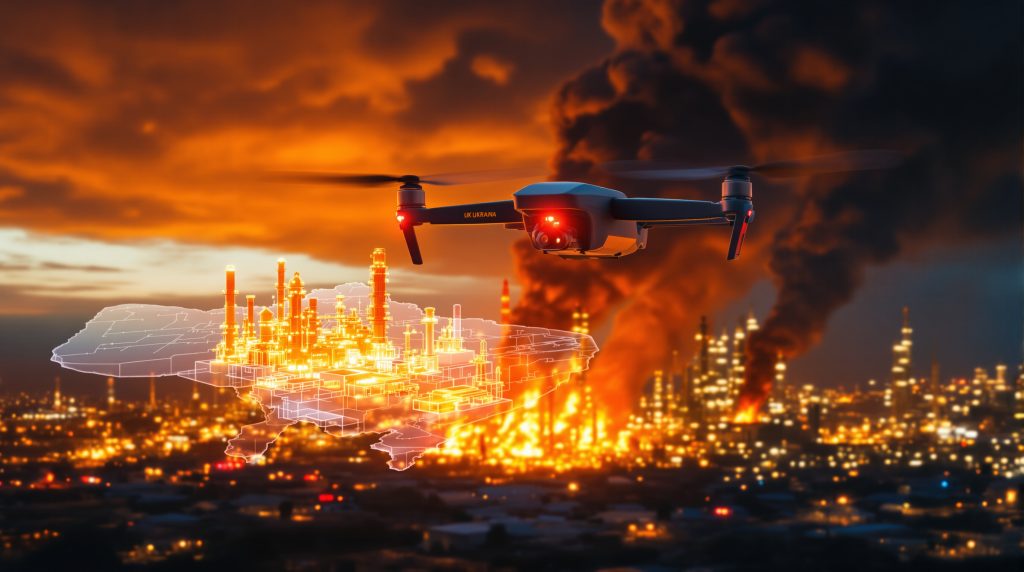Ukraine's Drone Strikes on Russian Oil Infrastructure: Strategic Impact and Consequences
The strategic landscape of the Russia-Ukraine conflict has evolved significantly with Ukraine's systematic targeting of Russian oil infrastructure using unmanned aerial vehicles. These precision strikes against facilities like the Rosneft Ryazan refinery demonstrate a sophisticated approach to asymmetric warfare that affects both Russia's military capabilities and its economy.
How Ukrainian Drones Target Russia's Oil Infrastructure
Ukrainian forces have demonstrated remarkable tactical sophistication in their drone operations against Russian oil infrastructure. The strike on the Rosneft Ryazan refinery showcases their ability to penetrate deep into Russian territory with unmanned aerial vehicles. These operations involve careful target selection, focusing on critical components within refineries that cause maximum disruption with minimal resources.
Ukraine has rapidly developed its drone warfare capabilities, utilizing both domestically produced and modified commercial drones. These systems can travel hundreds of kilometers into Russian territory, evade air defenses, and deliver precision strikes on specific infrastructure targets. The drones are specifically configured to identify and strike vulnerable processing units within refineries.
According to defense analysts, Ukrainian drone operations demonstrate a deep understanding of industrial vulnerabilities. Rather than simply aiming for the largest target, Ukrainian operators carefully select critical nodes that, when damaged, create cascading effects throughout the entire facility.
Coordination Between Special Units
The successful strikes on Russian oil infrastructure highlight seamless coordination between multiple Ukrainian military branches. Ukraine's Unmanned Systems Forces work in conjunction with Special Operations Forces and military intelligence to execute these complex operations.
This multi-unit approach enables operations requiring precise intelligence, tactical planning, and technical expertise. Intelligence units identify vulnerabilities and optimal timing, drone operators execute the precision strikes, and special forces may provide additional support or diversionary actions.
Military experts note that this level of coordination represents a significant evolution in Ukrainian tactical capabilities since the beginning of the conflict. What started as isolated drone attacks has developed into a cohesive campaign with strategic objectives.
What Makes the Ryazan Refinery a Critical Target
Strategic Importance in Russia's Oil Sector
The Rosneft Ryazan refinery ranks among Russia's largest and most important petroleum processing facilities. Located approximately 200 kilometers southeast of Moscow, it plays a crucial role in supplying fuel to central Russia and the military. With a processing capacity of approximately 17 million tons of crude annually (according to Rosneft's own data), it represents roughly 5-7% of Russia's total refining capacity.
The facility's strategic importance extends beyond its production volume. Its geographical position makes it a critical node in Russia's domestic fuel distribution network, particularly for supplying Moscow and western Russia with refined petroleum products. Any disruption to this facility creates ripple effects throughout Russia's fuel distribution system.
Technical Vulnerabilities Exploited
Ukrainian drone strikes specifically target the most vulnerable and critical components of refineries. At facilities like Ryazan, these include:
- Primary distillation units that separate crude oil into its component parts
- Catalytic crackers that convert heavy hydrocarbons into lighter, more valuable products
- Desulfurization units necessary for producing military-grade fuels
- Control systems that manage the refinery's operations
Petroleum engineering experts explain that modern refineries are highly integrated systems where damage to one unit can force the shutdown of multiple processes. For instance, damaging a primary distillation unit creates a bottleneck that limits the entire facility's production capacity.
Economic and Supply Chain Impact
Damaging critical units creates cascading effects throughout refinery operations, potentially forcing a complete shutdown or significant reduction in output. The precision of targeting specific units demonstrates Ukraine's understanding of refinery operations and vulnerabilities.
Industry analysts note that refineries operate with minimal spare capacity, and specialized replacement equipment often requires months to manufacture. This creates prolonged production losses that cannot be quickly remedied, leading to potential oil price crash analysis by market experts.
Extent of Damage to Russian Oil Facilities
Immediate Aftermath and Visual Evidence
Following drone strikes on Russian refineries, local eyewitnesses and social media channels often document substantial evidence of damage:
- Large fires erupting within refinery complexes
- Thick black smoke visible for kilometers around the facilities
- Emergency response vehicles rushing to contain blazes
- Partial or complete shutdowns of operations
Satellite imagery has confirmed multiple significant fires at Russian refineries following Ukrainian drone strikes. The thermal signatures visible from space indicate substantial damage to processing units rather than peripheral or storage areas.
Russian Defensive Claims vs. Reality
Russian authorities typically attempt to downplay the impact of Ukrainian drone strikes, claiming their air defenses intercept most incoming drones. However, they often acknowledge that drone debris struck "industrial sites" within refineries, and emergency teams are deployed to manage the consequences.
Industrial safety experts note that even if air defenses successfully destroy drones before they reach their targets, falling debris from intercepted drones can still cause significant damage to sensitive refinery equipment. Modern refineries contain kilometers of exposed piping, pressure vessels, and heat exchangers vulnerable to even small projectile impacts.
Operational Disruption Assessment
While the full extent of damage remains difficult to independently verify, energy analysts estimate:
- Successful strikes likely cause several weeks of disruption to refinery operations
- Repair work for specialized distillation equipment can extend to months
- Production capacity may be reduced by 30-50% during repairs
- Surrounding communities often report fuel supply disruptions following attacks
Market intelligence firms tracking Russian refinery throughput have detected significant decreases in production following reported drone strikes. These production losses align with visible damage in satellite imagery, contradicting Russian claims of minimal impact.
Ukraine's Broader Strategy Against Russian Energy Infrastructure
Pattern of Targeted Strikes
The Ryazan refinery attacks are not isolated incidents but part of a systematic campaign targeting Russia's energy infrastructure. Recent months have seen Ukrainian drone strikes on:
- Multiple major refineries across western Russia
- Fuel depots in Russian-occupied territories
- Oil storage facilities supporting military logistics
- Transportation infrastructure used for petroleum product distribution
This pattern reveals a deliberate strategy focused on maximizing economic and military impact while minimizing civilian casualties. By targeting fuel production and distribution rather than power generation used by civilians, Ukraine has created pressure points that primarily affect Russia's war-making capacity.
Economic Warfare Dimensions
These strikes represent a form of economic warfare designed to:
- Reduce Russia's domestic fuel production capacity
- Force Russia to redirect crude exports to compensate for refining shortages
- Create domestic fuel price increases within Russia
- Strain Russia's military supply chains
- Generate economic pressure on the Russian government
Energy economists estimate that drone strikes on Russian refineries have reduced the country's overall refining capacity by approximately 10-15% at various points in the conflict. This reduction forces Russia to choose between meeting domestic demand or maintaining export revenues, potentially influencing the OPEC production impact on global markets.
Military Logistics Impact
By targeting refineries and fuel depots, Ukraine aims to disrupt the fuel supply chain critical to Russia's military operations. Modern mechanized warfare requires enormous quantities of refined fuels, and these strikes complicate Russia's ability to maintain consistent supply lines to frontline forces.
Military logistics experts note that a modern armored division can consume 300,000 liters of fuel per day during active operations. Disruptions to fuel supplies force commanders to ration fuel, limiting operational tempo and mobility.
Russia's Response to Infrastructure Attacks
Defensive Measures and Counterclaims
Russia has responded to the escalating drone campaign with multiple defensive strategies:
- Deploying additional air defense systems around critical infrastructure
- Creating drone detection and jamming perimeters around key facilities
- Implementing blackout protocols to reduce visibility of facilities at night
- Claiming high interception rates of incoming drones
- Downplaying damage reports to maintain public confidence
Russian military communications have increasingly emphasized refinery defense as a priority mission for air defense units. This reallocation of air defense assets creates potential vulnerabilities elsewhere by thinning out coverage across Russia's vast territory.
Economic Adaptations
The Russian energy sector has been forced to adapt to the new reality of vulnerable infrastructure:
- Redistributing crude oil to undamaged refineries
- Increasing imports of refined products from friendly nations
- Adjusting domestic fuel pricing mechanisms
- Establishing emergency reserves near critical consumption centers
- Accelerating repair capabilities for damaged facilities
Energy market analysts have observed Russia increasing refined petroleum imports from Belarus, Kazakhstan, and other allied nations following major refinery strikes. These imports help compensate for domestic production losses but come with higher costs and logistical complications.
Propaganda and Information Operations
Russian authorities have used these attacks in information warfare by:
- Characterizing the strikes as "terrorism" rather than legitimate military operations
- Emphasizing civilian impacts while downplaying military significance
- Using the attacks to justify escalation in other domains
- Controlling media coverage of actual damage and impacts
Media monitoring organizations have documented consistent patterns in Russian reporting on refinery attacks. Initial reports typically acknowledge minor incidents, followed by claims of successful air defense interceptions, with minimal coverage of actual damage extent or repair timelines.
International Implications of These Attacks
Global Energy Market Ripple Effects
The ongoing campaign against Russian refineries has created subtle but significant effects in global energy markets:
- Temporary price volatility following major strikes
- Shifts in Russian export patterns from refined products to crude oil
- Increased refining activity in neighboring countries processing Russian crude
- Adjustments in global shipping patterns for petroleum products
Oil market analysts note that while global oil prices typically show limited reaction to individual refinery strikes, the cumulative effect of multiple successful attacks has created a small risk premium in European refined product prices. These developments have contributed to recent oil price rally insights observed by market experts.
Legal and Diplomatic Considerations
These strikes raise complex questions in international law and diplomacy:
- Debates over legitimate military targets versus civilian infrastructure
- Questions about proportionality and necessity in warfare
- Implications for energy security frameworks and critical infrastructure protection
- Potential precedents for future conflicts involving energy infrastructure
International legal experts generally consider petroleum refineries legitimate military targets when they contribute significantly to an adversary's war-fighting capability. However, the dual-use nature of these facilities creates ongoing debate about proportionality and civilian impact.
Western Response and Support
Western nations have carefully calibrated their responses to Ukraine's infrastructure campaign:
- Providing technical intelligence to support targeting decisions
- Supplying drone technology while maintaining plausible deniability
- Offering diplomatic support for Ukraine's right to strike military-supporting infrastructure
- Monitoring for potential escalation triggers
Defense analysts note that Western nations have progressively expanded their definition of acceptable targeting within Russian territory as the conflict has evolved, reflecting both Ukraine's demonstrated precision capabilities and Russia's continued targeting of Ukrainian civilian infrastructure.
Effects on Russia's War Capability
Fuel Supply Constraints
The cumulative effect of multiple refinery strikes has created measurable constraints on Russia's military logistics:
- Increased transportation distances for fuel reaching frontline units
- Higher costs for military fuel procurement
- Occasional rationing of fuel for non-priority operations
- Reallocation of strategic reserves to maintain critical operations
Military intelligence assessments indicate that Russian units operating in certain sectors have experienced reduced operational tempo following major refinery strikes. These constraints particularly affect fuel-intensive operations involving armored vehicles and aviation assets.
Economic Pressure Points
Beyond direct military impacts, the strikes create broader economic pressures:
- Diversion of resources to repair and protect infrastructure
- Increased security costs across the energy sector
- Insurance premium increases for Russian energy facilities
- Investor uncertainty regarding Russian energy assets
Economic analysts estimate that Russia has been forced to allocate billions of dollars to refinery repairs, air defense systems, and other protective measures that would otherwise have supported its war effort or domestic economy.
Psychological and Morale Effects
The ability of Ukrainian forces to strike deep within Russian territory creates significant psychological effects:
- Demonstrates vulnerability of Russian homeland to Ukrainian capabilities
- Creates public awareness of the war's costs within Russia
- Forces Russian military to allocate resources to homeland defense
- Challenges the Kremlin's narrative of military superiority
Social media monitoring reveals increased Russian civilian concern about fuel prices and availability following major refinery strikes, creating domestic political pressure that the Russian government must address alongside its military challenges.
Russian Countermeasures Implementation
Enhanced Air Defense Systems
Russia has responded by significantly upgrading air defenses around critical infrastructure:
- Deploying additional Pantsir-S1 and S-300/400 systems near key facilities
- Creating layered defense zones with overlapping coverage
- Implementing 24/7 radar surveillance around major refineries
- Establishing rapid response teams for drone incursions
Defense experts note that this reallocation of air defense assets represents a significant success of Ukraine's drone campaign, as these systems would otherwise be deployed to protect military assets or forward positions.
Decentralization and Redundancy
The Russian energy sector has begun implementing structural changes to reduce vulnerability:
- Distributing critical processes across multiple smaller facilities
- Creating redundant systems for essential refinery components
- Establishing alternative supply routes for key regions
- Developing rapid repair capabilities for damaged infrastructure
Energy infrastructure specialists observe that these adaptations, while effective at reducing vulnerability, increase operating costs and reduce overall efficiency in Russia's refining sector.
Operational Security Improvements
Russia has also enhanced operational security measures:
- Reducing electronic emissions that could guide drone targeting
- Implementing stricter information controls around facility operations
- Creating physical camouflage and deception measures
- Conducting regular drills to respond to drone attacks
Satellite imagery analysis has detected increased camouflage netting, smoke generators, and other concealment measures at Russian refineries that previously operated without such protective measures.
How This Campaign Might Evolve
Technological Escalation
Both sides are likely to escalate the technological aspects of this campaign:
- Ukraine developing more sophisticated drones with enhanced range and payload
- Russia implementing more advanced counter-drone technologies
- Both sides engaging in electronic warfare to control the electromagnetic spectrum
- Potential deployment of AI-enhanced targeting and defense systems
Defense technology experts anticipate an acceleration in drone countermeasure development, with Russia likely to prioritize directed energy weapons, advanced jamming systems, and automated counter-drone platforms to protect critical infrastructure.
Potential Target Expansion
Ukraine may consider expanding its target set beyond refineries to include:
- Power generation facilities supporting military production
- Transportation nodes critical to energy distribution
- Command and control centers coordinating energy security
- Secondary processing facilities for specialized military fuels
Strategic analysts note that Ukraine has thus far demonstrated remarkable target discrimination, focusing on facilities with clear military significance while avoiding targets that would primarily impact Russian civilians. Some experts draw parallels to policy discussions surrounding Alaska drilling policy shift in terms of energy security implications.
Seasonal and Weather Considerations
The approaching winter months will influence this campaign:
- Increased Russian vulnerability due to higher heating fuel demands
- Weather challenges for drone operations during winter conditions
- Greater impact of successful strikes during peak energy consumption periods
- Strategic timing of attacks to maximize disruption during critical periods
Energy security experts point out that winter fuel shortages would have greater impact than similar shortages during warmer months, potentially increasing the strategic value of successful strikes as temperatures drop.
FAQ: Ukraine's Drone Campaign Against Russian Oil Infrastructure
What percentage of Russia's refining capacity has been affected by Ukrainian drone strikes?
Ukrainian drone strikes have impacted approximately 15-20% of Russia's total refining capacity through direct damage and precautionary shutdowns. Individual major refineries like the Ryazan facility represent roughly 5-7% of Russia's refining capability each.
Are these strikes considered legitimate military targets under international law?
Military legal experts generally consider petroleum refineries legitimate military targets when they contribute to an adversary's war-fighting capability. However, debates continue regarding proportionality, civilian impact, and the dual-use nature of energy infrastructure.
How are these strikes affecting civilian fuel prices in Russia?
Fuel prices in regions dependent on affected refineries have seen increases of 10-15% following successful strikes. The Russian government has implemented price controls and redistribution measures to minimize civilian impacts, but localized shortages have been reported.
What defensive technologies is Russia using to protect its refineries?
Russia employs a multi-layered defense approach including radar systems, electronic warfare jammers, physical barriers, and anti-aircraft systems such as Pantsir-S1 and S-400 complexes. They have also implemented early warning networks and rapid response protocols.
How are global oil markets responding to these attacks?
Global oil markets have shown remarkable resilience, with only short-term price volatility following major strikes. The primary market impact has been shifts in trade flows rather than significant price increases, as global refining capacity has absorbed the disruptions. However, some analysts see these developments intersecting with oil price trade war dynamics in complex ways.
Further Exploration
Readers interested in learning more about the strategic implications of infrastructure targeting in modern warfare can explore related educational content that offers ongoing coverage of energy security developments in conflict zones. For detailed reporting on recent developments, see Ukraine's drone strikes on Russian refineries and Ukrainian strikes on oil facilities in Russia's Ryazan region.
Disclaimer: This analysis reflects the current situation based on available information. The dynamic nature of the conflict means that circumstances may change rapidly. The article does not endorse any particular approach to warfare or make specific predictions about future military operations.
Want to Stay Ahead of ASX Mining Investment Opportunities?
Discovery Alert's proprietary Discovery IQ model delivers real-time alerts on significant ASX mineral discoveries, instantly empowering subscribers to identify actionable opportunities ahead of the broader market. Explore why historic discoveries can generate substantial returns by visiting the dedicated discoveries page and begin your 30-day free trial today.




